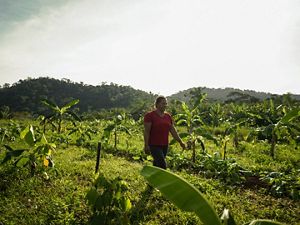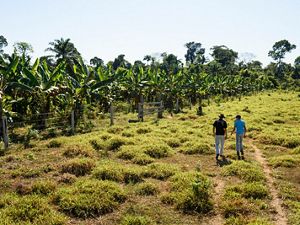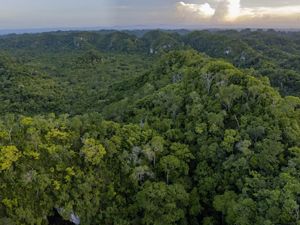It’s Time to Embrace the Potential of Agroforestry as a Climate Solution
Adding native trees to agricultural lands improves biodiversity and farmer livelihoods, and can help address the climate crisis at a global scale.
Drew Terasaki Hart, Susan Cook-Patton, Edenise Garcia, Rémi Cardinael, Starry Sprenkle-Hyppolite, Todd Rosenstock
Birds flit among lush green branches. A few leaves rustle underfoot. Pollinators visit fruit trees and howler monkeys call in the distance. In many ways, it feels like a forest, and yet this is a farm in São Felix do Xingu, in Pará State, Brazil—or more technically an “agroforest”.
There are many different types of agroforests across the globe, from Leucaena hedgerows that feed livestock to rows of poplars striping wheat fields to cacao farms with protective layers of shade trees. Some systems reflect longstanding indigenous and traditional practices, while others are adapted for large-scale commercial agricultural systems.
Despite the diversity, agroforestry systems all share one common feature—trees that are deliberately incorporated and maintained in agricultural landscapes. These trees can help to enrich soils, boost yields, buffer crops and livestock from climate extremes, diversify incomes and support biodiversity.
There is also great hope that agroforestry systems can prove a valuable ally in tackling climate change, offering up to 0.31 billion metric tons of carbon removal per year1. Despite this potential, climate-focused agroforestry is under-appreciated.
Our study, recently published in Nature Climate Change, also found that not all agroforestry systems help to tackle climate change. The figure below shows that whether agroforestry represents a natural climate solution depends on the natural state of the land and how it was previously managed. Thinning a natural forest to establish crops would emit carbon into the atmosphere, and putting many trees in native grasslands would harm biodiversity. So, what does a good climate-focused agroforestry system look like? Think: bringing back native tree species to land that was converted for agriculture. Replacing degraded agricultural lands with shade-grown cacao systems in a previously forested area such as the Brazilian Amazon, for example, can bring substantial climate benefits as well as improved livelihoods for local communities.

Quote: - Drew Terasaki Hart
“We have the know-how and the space to add more trees to global farmlands. Science can help identify the places where agroforestry has the largest potential for climate change mitigation, while providing multiple other benefits including supporting agricultural production and wildlife habitat."
Watch: Agroforestry in Practice



To help agroforestry achieve its potential as a climate solution, we gathered key scientists from research organizations across the globe to identify three knowledge gaps that must be filled.
First, we need a better understanding of the climate potential of agroforestry.
We do not have good estimates of the mitigation potential of specific agroforestry systems. Even the best-available estimates from the International Panel on Climate Change and others2 are too uncertain. For example, we found up to 100-fold variation that can occur across silvopasture systems. Silvopasture combines trees and grazing lands and can enhance production by protecting livestock from extreme heat. Because silvopasture systems can range from one or a few trees in a field up to full forest canopy a single average carbon value will never be sufficiently accurate. The solution to this key science gap is to both improve measurement and reporting, but also to pull together the immense information that already exists. That information is currently scattered across hundreds of often hard-to-access scientific papers – making it tough for farmers and decision-makers to get robust information on how much carbon can be stored in trees and soils in agroforestry systems. We are already working on building a global agroforestry carbon database, so stay tuned.

We need more information about where the world’s existing agroforestry systems are found.
We really do not know where all the successful agroforestry systems are. Our work demonstrated that existing agroforestry maps3 miss some of the most carbon-rich agroforestry systems in the world. Fortunately, new and emerging remote sensing methods are increasingly poised to help map and monitor agroforestry systems. However, those methods need to be trained with known agroforestry locations and our review found that less than half of the 465 scientific papers we reviewed reported locations with sufficient precision to be useful. Reporting more accurate geolocations would really help to accelerate the mapping of agroforestry, which would improve our understanding of how much carbon is held within these systems and where they could be expanded to provide additional climate mitigation.

Quote
"We are in the decade of delivery and the science is clear that agroforestry has immense promise to help mitigate climate change while also improving agricultural livelihoods and sustainability."
We need the right incentives in the right places to enable the expansion of agroforestry as a climate solution.
We found that adoption, ambition, and potential for agroforestry are not distributed evenly across the globe. Some countries, especially those in Africa are leading the way, but there is substantial room for expansion with the right designs and incentives, especially in the Global North. Momentum is growing. The Nature Conservancy and multiple partners, for example, received a $60 million grant from the United States Department of Agriculture to advance agroforestry across 29 states.
We are in the decade of delivery and the science is clear that agroforestry has immense promise to help mitigate climate change while also improving agricultural livelihoods and sustainability. However, as our work shows, we need a concerted push across multiple sectors to transition the potential of agroforestry to practice.
As growing demand for food, fiber, and fuel increases pressure on land around the world, we need to be smart about how to meet these demands while reducing emissions to avoid the worse effects of climate change. Agroforestry is a solution to both. It’s time we embraced it.
This effort brought together leading scientists from multiple internationally recognized organizations that are seeking to bring agroforestry to scale as a climate solution. While led by the Nature Conservancy, it was made possible through collaboration with scientists from Princeton University, CIRAD, Agroscope, University of Missouri, International Center for Tropical Agriculture, Conservation International, World Resources Institute, World Agroforestry Centre, Yale University. A grant to the Nature Conservancy from the Bezos Earth Fund supported this work.
The full paper is available for free here:
Read and downloadTerasaki Hart D.E., Yeo S., Almaraz M., Beillouin D., Cardinael R., Garcia E., Kay S., Lovell S.T., Rosenstock T.S., Sprenkle-Hyppolite S., Stolle F., Suber M., Thapa B., Wood S., Cook-Patton S.C. Priority Science Can Accelerate Agroforestry as a Natural Climate Solution. Nature Climate Change.
10.1038/s41558-023-01810-5
1 Roe et al. 2021 Global Change Biology 27(23): 6025-6058
2 Cardinael et al 2018 Environ. Res. Lett. 13 124020
3 Chapman et al. 2020 Global Change Biology 26(8): 4357-4365



